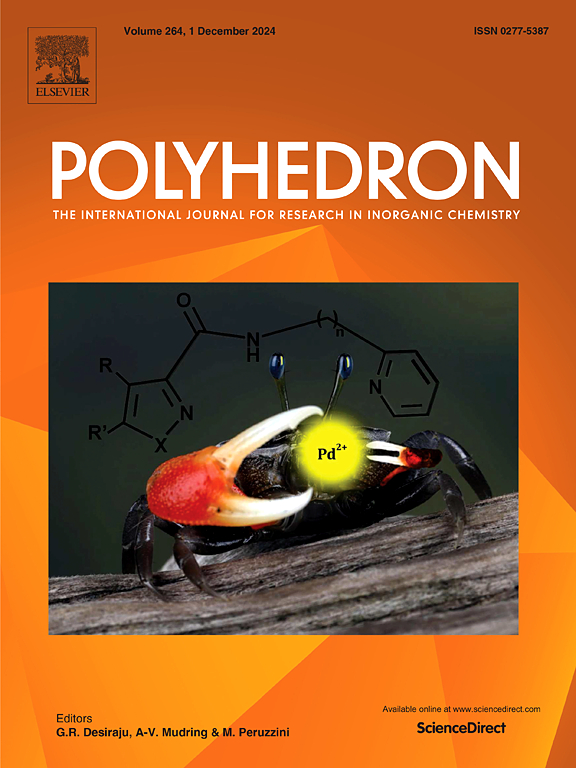2-苯甲酰吡啶卤化铜/伪卤化铜加合物的合成、表征及[di-μ-碘-双(N, o- 2-苯甲酰吡啶)二铜(I)的x射线晶体结构]
IF 2.6
3区 化学
Q2 CHEMISTRY, INORGANIC & NUCLEAR
引用次数: 0
摘要
已制备并表征了X = Cl、Br、I、SCN和N3的CuXL型深棕色铜配合物和X = Cl或Br的(CuX)2L型橙黄色配合物,其中L = 2-苯甲酰吡啶。在丙酮和硝基苯溶液中,所有配合物均表现出较强的CT波段。红外光谱数据表明,2-苯甲酰吡啶在橙黄色配合物中作为单齿配体,在棕色配合物中作为双齿螯合配体,而桥接卤化物和假卤化物在这两种类型中都存在。通过x射线晶体学测定,1:1黑色碘化物配合物的结构具有离散的、中心对称的[CuI(2-苯甲酰基吡啶)]2分子,其Cu⋯⋯Cu距离为2.587(1)Å。二聚体分子中的每个铜原子与2-苯甲酰基吡啶配体的两个μ-碘原子和羰基氧、氮原子呈四面体配位。当在紫外区激发时,橘黄色配合物显示可见的发射,而棕色配合物则没有。本文章由计算机程序翻译,如有差异,请以英文原文为准。
Synthesis and characterization of copper(I) halide/pseudohalide adducts of 2-benzoylpyridine and x-ray crystal structure of [di-μ-iodo-bis(N,O-2-benzoylpyridine)dicopper(I)]
Dark-brown copper(I) complexes of the type CuXL, for X = Cl, Br, I, SCN and N3, and orange-yellow complexes of the type (CuX)2L, for X = Cl or Br, where L = 2-benzoylpyridine, have been prepared and characterized. All complexes exhibit strong CT bands in the visible region and gave non-conducting solutions in acetone and nitrobenzene. The IR spectral data suggest that 2-benzoylpyridine acts as a monodentate ligand in the orange-yellow complexes and as a bidentate chelating ligand in the brown complexes, whereas bridging halides and pseudohalides exist in both types. The structure of the 1 : 1 black iodide complex, as determined by X-ray crystallography, features a discrete, centrosymmetric [CuI(2-benzoylpyridine)]2 molecule with a short Cu⋯Cu distance of 2.587(1) Å. Each copper atom in the dimeric molecule is tetrahedrally coordinated by two μ-iodine atoms and the carbonyl oxygen and nitrogen atoms of the chelating 2-benzoylpyridine ligand. The orange-yellow complexes display visible emission when excited in the UV region, whereas the brown complexes do not.
求助全文
通过发布文献求助,成功后即可免费获取论文全文。
去求助
来源期刊

Polyhedron
化学-晶体学
CiteScore
4.90
自引率
7.70%
发文量
515
审稿时长
2 months
期刊介绍:
Polyhedron publishes original, fundamental, experimental and theoretical work of the highest quality in all the major areas of inorganic chemistry. This includes synthetic chemistry, coordination chemistry, organometallic chemistry, bioinorganic chemistry, and solid-state and materials chemistry.
Papers should be significant pieces of work, and all new compounds must be appropriately characterized. The inclusion of single-crystal X-ray structural data is strongly encouraged, but papers reporting only the X-ray structure determination of a single compound will usually not be considered. Papers on solid-state or materials chemistry will be expected to have a significant molecular chemistry component (such as the synthesis and characterization of the molecular precursors and/or a systematic study of the use of different precursors or reaction conditions) or demonstrate a cutting-edge application (for example inorganic materials for energy applications). Papers dealing only with stability constants are not considered.
 求助内容:
求助内容: 应助结果提醒方式:
应助结果提醒方式:


